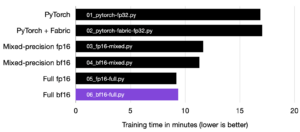
Today, I’m thrilled to share that Mike Ruberry, one of PyTorch’s core technical leads, will be joining Lightning.
If you’re a PyTorch user, you’ve benefited directly from Mike Ruberry’s work. Today, I’m super excited to announce the creation of the PyTorch Team at Lightning (formerly known as PyTorch Lightning) that Mike will be leading.
Mike Ruberry, a PyTorch core technical lead who’s been with the project for over four years, joins us as the first member and Chief Engineer of the PyTorch Team at Lightning. Mike shares my passion (and that of our CTO Luca — more from him in a bit) for making PyTorch the go-to framework for deep learning. On behalf of the Lightning community, Luca and I are thrilled to welcome Mike Ruberry to Lightning AI!
Some highlights of Mike’s work at PyTorch include shepherding the design and upstreaming of automated mixed precision (AMP), efforts to make PyTorch consistent with NumPy, including the creation of torch.fft, torch.linalg and torch.special. Most recently, he’s been focused on how PyTorch programs are represented to ensure they are fast and composable.
Over the years, Mike and I have been building a bridge between the Lightning community (join our Slack here) and the core PyTorch team at Meta, in order to improve usability for the PyTorch community. We did this by removing blockers and simplifying the API for scalable model development and deployment. Today, this sentiment is one we’ve embraced in our community, to make it one of the most vibrant places to learn from each other, collaborate and collectively push AI forward.
· · ·
PyTorch at Lightning
The PyTorch Team at Lightning is a major milestone in our community’s evolution. It’ll allow us to build on lightning.ai, which we launched earlier this year: a platform that provide templates for machine learning workflows. These templates allow you to connect AI models with the ML lifecycle — all without handling DIY infrastructure, cost management, scaling, and other headaches. The PyTorch Team at Lightning’s mission is to not only deliver the best PyTorch + Lightning combination, but to help shape the direction of PyTorch itself.
From day 1 in 2015, when I started working on Lightning for my own research as an undergrad, I believed that PyTorch’s fundamental different approach to building ML would make it the dominant framework in deep learning. Today, my conviction is 100x stronger. First, the research community adopted it, and now enterprises have also followed suit. Even though PyTorch adoption is great, we’re aware that there’s always room to enhance the framework and make it even better for the community. We believe PyTorch has the ability to become bigger, better, faster, easier to use and more extensible. These are the core principles that the PyTorch team at Lightning will be pursuing. Our friend Soumith Chintala, core maintainer at Meta, summed it up best when he said, “Having a PyTorch core team balanced among many stakeholders is fundamental to our success. I’m really happy to see a PyTorch team at Lightning, and I couldn’t think of a better person to kick it off than Mike Ruberry.”
· · ·
By Researchers, for Researchers
I chose PyTorch to power Lightning because of its flexibility, and the fact that it was written by researchers for researchers. Today, our team is humbled to find that over 46% of PyTorch users use Lightning alongside it. As a researcher, this is the foundational idea behind Lightning: a framework designed first for flexibility, and that has now evolved to power some of the largest production systems in the world, ranging from core products at Meta to Amazon Search.
As we invest in PyTorch as the framework to power Lightning, we decided to build an in-house team who have been crucial in shaping the project’s trajectory. With our CTO Luca Antiga as an early key contributor to PyTorch, the addition of Mike Ruberry signals the start of a deliberate effort to formalize a proper PyTorch Team at Lightning.
Meta has been a design partner on Lightning since I left FAIR in 2019. Today we’re creating this new team to further the collaboration and work on the core framework together. Mike, Luca and I are personally excited to reaffirm our commitment to PyTorch as the ideal framework to power Lightning today, and to ensure that the PyTorch and Lightning teams collectively towards the success of the ML community.
· · ·
A Word from Luca Antiga, our CTO
Ever since PyTorch was released in early 2017 and I started contributing to it in the early days, I’ve always been amazed by the developer-first stance that the creators of PyTorch took very early on, and the strong community ethos that came with it. I believe that this is one of the key reasons why PyTorch powers much of the AI landscape today, beyond the technical achievements.
Lightning was born on very similar core principles and this has always been a strong motivating factor for me. The value we place on the community allows researchers to participate in shaping their favorite framework, and more recently to extend their reach from building models to building entire AI products end-to-end.
Today, with Mike joining and the PyTorch team at Lightning kicking off, we have the concrete opportunity to help propelling PyTorch into the future, and at the same time to establish our vision for Lightning as the best framework for developers and AI creators.
Ever since I stopped being a core contributor to PyTorch in late 2018, I’ve been mesmerized at the progress that the core PyTorch team has made and how far the project has evolved. This was thanks to an exceptional team of researchers and engineers that worked at very hard problems while keeping the experience for users consistent. One of most prominent figures among those was and still is Mike, and I feel extremely fortunate to have the opportunity to work alongside him today, improving PyTorch and making sure Lightning leverages its evolutions.
I can’t wait for what the next few months will unlock, for PyTorch, for Lightning and for the combination of the two.
